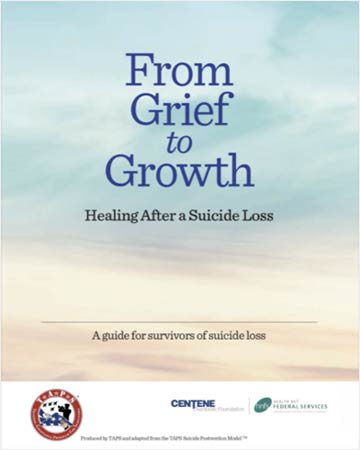Launch of “From Grief to Growth: Healing After a Suicide Loss”
Author: Carla Stumpf Patton
The TAPS Suicide Postvention Department is proud to present the newly released guidebook, “From Grief to Growth: Healing After a Suicide Loss”. Think of this as a roadmap to help navigate the path of grief due to suicide. If you are grieving the death of a loved one to suicide, we are saddened to know of your loss. Having been there ourselves, we understand as much as anyone possibly could and we want to support you on this difficult journey. This guidebook was adapted in part from the TAPS Suicide Postvention ModelTM developed by TAPS staff who are survivors; so this is written by survivors for survivors and is intended to offer guidance that we hope may help along journey toward healing. As you read, please keep in mind that as heartrending, stressful, and isolating as your grief may be...You are not alone. You can survive this. Whatever you are feeling is valid and okay (as long as it is not harmful to yourself or others). TAPS is here to support and walk beside you along the way.


A glimpse inside
“The grief one experiences from a suicide loss differs from that of other kinds of loss. Suicide loss brings with it many factors that can make the journey more difficult. You may be feeling a mix of emotions that are conflicting and overwhelming. We know, because we are suicide loss survivors, too. We assure you that all of these complicating issues are completely normal. This guide will help you address many of them. The intense sorrow and pain that comes from a suicide loss can feel overwhelming. You may not know where to start or even how you will survive. At TAPS, we have collected information from thousands of survivors and hundreds of professionals to put together a roadmap that will help you navigate this journey. We call it the TAPS Suicide Postvention ModelTM. This model will help you stabilize, grieve, and grow. One step at a time... The primary phases of the Model are Stabilization, Grief Work, and Posttraumatic Growth. Stabilization, the most important phase of the Model, will help you address key issues as you and your family work to rebuild a solid foundation. This guide focuses mainly on this phase. Note that Stabilization and this guide are intended not just for new survivors, but all survivors. If your loss was a long time ago, even many years ago, and you are still feeling stuck on certain issues, walking through this guide can help you deal with unresolved problems, confusing emotions, and lingering concerns and questions.”
Since 2008, the Tragedy Assistance Program for Survivors has supported more than 19,000 survivors of military suicide loss by offering them hope, healing, and renewed opportunities for personal growth. We’re here to help you, too. You can learn more by visiting the TAPS Suicide Loss Support page or email at Suicidepostvention@taps.org.
Dr. Carla Stumpf Patton is TAPS Senior Director of Suicide Postvention Programs and surviving spouse of D.I. Sgt. Richard Stumpf, USMC.

